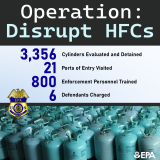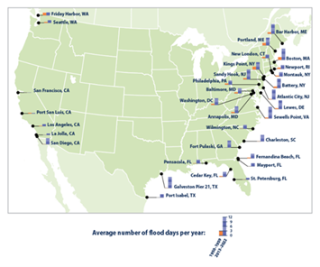Addressing Climate Change in Enforcement and Compliance Assurance
EPA’s enforcement and compliance program is focused on addressing 21st century environmental challenges, none of which are greater than global climate change. The climate crisis continues to accelerate: the summer of 2024 was the northern hemisphere’s hottest in 175 years. As of November 1, 2024, there were 24 confirmed weather/climate disaster events impacting the United States with losses exceeding $1 billion each. Decisive action must be taken to tackle the climate crisis. Enforcing and driving compliance with our nation’s laws is an essential component of a comprehensive approach to addressing climate change.
EPA has taken several steps to combat climate change during the last three years, including establishing new regulations to curb climate pollutants that must be enforced vigorously to help stave off catastrophic climate change. EPA has, for the first time, prioritized enforcement and compliance actions that mitigate climate change and is including climate adaptation and resilience measures in enforcement and compliance activities whenever appropriate.
The enforcement and compliance climate change initiative focuses on reducing air pollutants that cause or contribute to climate change, in particular two climate super pollutants – methane and hydrofluorocarbons (HFCs) along with other greenhouse gases.
This overview of EPA’s work to address climate change in enforcement and compliance assurance focuses on mitigating climate change and incorporating climate adaptation and resiliency, as well as provides EPA resources, tools, and training information.
On this page:
- EPA Climate Enforcement and Compliance Strategy
- Mitigating Climate Change
- Climate Change Adaptation and Resiliency
- Capacity Building and Technical Assistance
EPA Climate Enforcement and Compliance Strategy
During his first week in office, former President Biden issued Executive Order 14008 calling on all federal agencies to “combat the climate crisis with bold, progressive action” and directed them to reduce emissions of greenhouse gases (GHGs), bolster adaptation to alter our behaviors, and increase resilience to the impacts of climate change. EPA Administrator Regan subsequently made addressing the climate crisis the top cross-cutting goal in EPA’s Strategic Plan.
Building off this, on September 28, 2023, EPA’s former Assistant Administrator for the Office of Enforcement and Compliance Assurance issued EPA’s Climate Enforcement and Compliance Strategy directing all EPA enforcement and compliance offices to address climate change, wherever appropriate, in every matter within their jurisdiction.
This first-ever strategy targeting climate change requires EPA’s enforcement and compliance programs to:
- Prioritize enforcement and compliance actions to mitigate climate change, particularly for climate super-pollutants, methane and hydrofluorocarbons (HFC)
- Include climate adaptation and resilience in case conclusions, as appropriate; and
- Provide technical assistance to achieve climate-related solutions and build climate change capacity among EPA staff and our state and local partners.
The strategy also recognizes that while the impacts of climate change affect people in every region of the country, certain communities and individuals already overburdened by environmental stressors and that have less access to the resources needed to adapt to and recover from climate change impacts are especially vulnerable. Under this strategy, EPA’s enforcement and compliance program will consider climate equity as we factor climate change considerations into our enforcement and compliance activities.
Mitigating Climate Change
EPA is working with our state, local, and Tribal partners to prioritize enforcement and compliance assurance activities that reduce air pollutants that cause or contribute to climate change (i.e., carbon dioxide, methane, and fluorinated gases).
EPA’s goal to achieve meaningful reductions in greenhouse gas emissions to prevent the worst effects of climate change will depend upon the strength of EPA’s climate rules, the efforts of the regulated community to comply with those rules, and the willingness of the agency to take swift enforcement action against violators.
EPA is using all its enforcement and compliance tools at its disposal, including using civil and criminal enforcement authorities, to ensure our nation’s laws governing climate pollutants are adhered to. EPA is also using a variety of investigative and monitoring techniques including on- and off-site inspections, mobile vehicle monitoring, and drone technology.
EPA’s efforts to mitigate climate change include the following:
National Enforcement and Compliance Initiative
In August 2023, EPA included Mitigating Climate Change as one of six National Enforcement and Compliance Initiatives or NECIs for FY 2024-2027 and will focus additional resources on reducing emissions of the highest impact climate super pollutants - hydrofluorocarbons (HFCs)and methane. This is the first time mitigating climate change is included as one of EPA’s NECIs. More information is available on the FY 2024 annual results for addressing climate change and the Mitigating Climate Change NECI.
Operation Disrupt HFCs

The 2020 American Innovation and Manufacturing (AIM) Act authorizes EPA to address HFCs, a climate super pollutant, with global warming potentials hundreds to thousands of times higher than carbon dioxide (CO2)in three main areas:
- Phase down the production and consumption of listed HFCs in the United States by 85% by 2036
- Manage these HFCs and their substitutes, and
- Facilitate the transition to next-generation technologies that do not rely on HFCs.
In February 2024, EPA’s criminal enforcement program, the Office of Criminal Enforcement Forensics and Training (OCEFT), initiated “Operation: Disrupt HFCs,” to impact the illegal supply chain of HFC refrigerants entering into US commerce without allowances. Read more: Operation: Disrupt HFCs webpage.
Methane Enforcement
EPA will also seek greater compliance with existing environmental laws at oil and gas facilities and landfills, the second and third largest sources of U.S. methane emissions as methane is also a potent greenhouse gas with a global warming potential 28 times higher than carbon dioxide.
Tackling Greenhouse Gases
In addition to the Mitigating Climate Change NECI, EPA’s day-to-day enforcement actions to return facilities to compliance with existing laws are directly and indirectly resulting in the reduction of greenhouse gases.
In some cases, EPA enters settlement agreements where companies will commit to increase energy efficiency, conserve energy, or switch fuels, resulting in a reduction in carbon dioxide (CO2) emissions, the largest source of U.S. greenhouse gas emissions.
EPA’s enforcement program is also including clean renewable energy (wind, solar, etc.), energy efficiency, and electrification requirements into settlement agreements, where appropriate, that allow entities to reduce their carbon dioxide emissions while continuing to operate in compliance with our environmental laws.
Climate Change Adaptation and Resiliency

The impacts of climate change (e.g., floods, fires, hurricanes, extreme weather events) pose additional challenges for regulated entities to remain in compliance with our nation's environmental laws and for communities, including those underserved and overburdened by pollution, to anticipate, prepare for, withstand, and recover from extreme weather events.
To protect communities from climate change that is already occurring and anticipated changes that will occur, EPA is including climate adaptation and resilience whenever possible in criminal and civil settlements agreement.
>More information and case highlights illustrating EPA’s climate change adaptation and resiliency efforts are available on our Incorporating Climate Adaptation in Enforcement and Compliance Assurance Actions webpage.
Capacity Building and Technical Assistance
Through EPA’s climate and enforcement strategy, the agency is working to provide technical assistance to achieve climate-related solutions and build climate change capacity among EPA staff and our state and local partners.
The Agency’s enforcement and compliance program is taking steps to improve our own adaptive capacity so that climate change does not interfere with EPA’s ability to conduct compliance monitoring activities and enforce the nation’s environmental laws.
